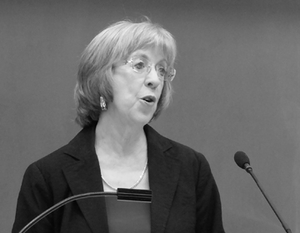Mary Anne Waldron
Professor Mary Anne Waldron has been a faculty member in the Faculty of Law at the University of Victoria since 1976. She has extensive experience in both teaching and administration. On the administrative side, she has served as Associate Dean and, later, Acting Dean of the Faculty and then served eight years as Associate Vice-President Legal Affairs for the University. Most of her teaching and research in the Law Faculty has been in the areas of commercial law, but she has also pursued her interests in teaching law to non-lawyers and in analyzing Canadian court decisions in light of their political, moral and ethical implications. Her recent book, Free to Believe: Rethinking Freedom of Conscience and Religion in Canada (University of Toronto Press, 2013) reflects both those commitments.
Bio last updated June 17th, 2021.

Articles by Mary Anne Waldron

Campuses, Courts and Culture Wars
By Mary Anne Waldron
February 1, 2014
Law Professor Mary Anne Waldron fears for religious freedom
Is that now to change? If not, why should a lawyer's beliefs and thoughts be scrutinized only on this one issue? And, finally, while same-sex marriage is legal in Canada, where core religious principles are jeopardized by recognition of its morality, cases suggest that freedom of religion under the Charter can be a defence to claims of illegal discrimination under human rights legislation Might a university incur liability where it permits the repression of freedom of conscience and religion or, at least, discrimination against students on the basis of religion, on its property by student societies without exercising what control it may have through various means? The UVSS-CSA conflict raises all these questions, which, as yet, remain unanswered Based on decisions of the Supreme Court of Canada, the fact that the "public" is limited in this case to undergraduate university students at UVic does not defeat that conclusion While the most obvious example of this would be the proposed legislation in Quebec banning the wearing of religious symbols, we can also point to other incidents: the Alberta government's refusal to continue the long-standing exception for Hutterites carrying driver's licences without photographs, and its success in defending this refusal in the Supreme Court of Canada; the refusal of the Saskatchewan Court of Appeal to uphold proposed legislative amendments to protect the conscience of marriage commissioners; and the position taken by the Ontario Human Rights Commission on physicians who refuse to perform abortions or prescribe contraceptives When the students refused, they were charged with trespass and given penalties under the non-academic misconduct policy of the university for failing to obey the instructions of campus security in the performance of their duty As these examples demonstrate, the usual turn of events in a clash of beliefs is the repression of one belief at the behest of another through, in some cases, violence and, in others, the exercise of power by religious authority or the State University of British Columbia (Okanagan) Students' Union, the pro-life club had been funded for a year by the student union It does not remove the fact that for the vast majority of people, religious or not, sexual conduct forms a part of their moral belief system This is typical of the general landscape of religious freedom in Canada Courts and tribunals treat issues of religious freedom with great caution, in many cases appearing to recognize little value in the fundamental freedom other than personal fulfillment In the first case, the claimants argued before the human rights tribunal that they were discriminated against on the basis of political belief, contrary to section 14 of the Human Rights Code Interestingly, if the Charter does apply to universities in some measure, then the requirement of compulsory membership in student associations imposed by the university might well be contrary to freedom of association, guaranteed in section 2 of the Charter
